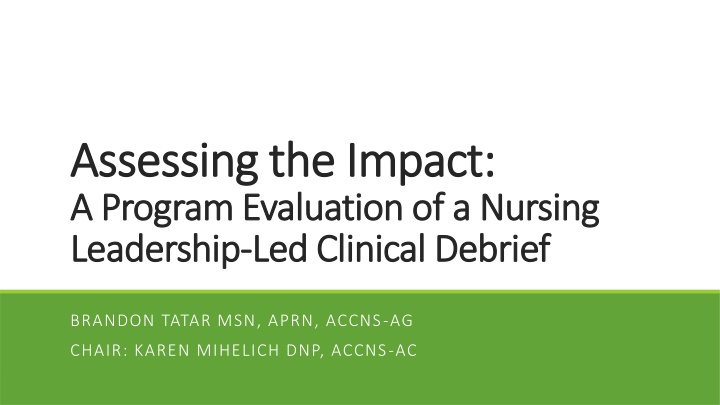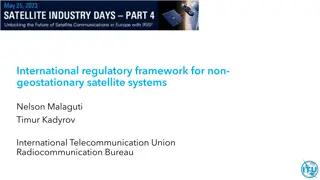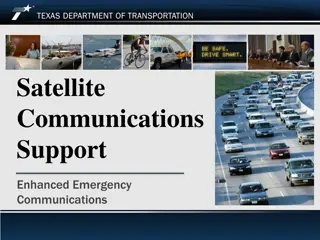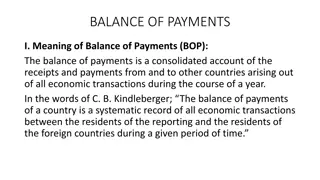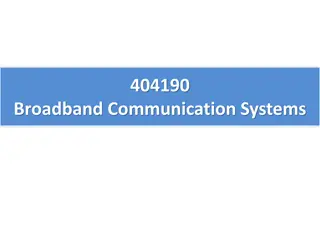Stylized Satellite Account for Human Capital Presentation
This presentation explores the concept of human capital, its implications for measurement, importance in the System of National Accounts, and the output of the education sector. It discusses different measuring methodologies and the challenges of incorporating human capital into economic frameworks.
Download Presentation

Please find below an Image/Link to download the presentation.
The content on the website is provided AS IS for your information and personal use only. It may not be sold, licensed, or shared on other websites without obtaining consent from the author.If you encounter any issues during the download, it is possible that the publisher has removed the file from their server.
You are allowed to download the files provided on this website for personal or commercial use, subject to the condition that they are used lawfully. All files are the property of their respective owners.
The content on the website is provided AS IS for your information and personal use only. It may not be sold, licensed, or shared on other websites without obtaining consent from the author.
E N D
Presentation Transcript
Assessing the Impact: Assessing the Impact: A Program Evaluation of a Nursing A Program Evaluation of a Nursing Leadership Leadership- -Led Clinical Debrief Led Clinical Debrief BRANDON TATAR MSN, APRN, ACCNS-AG CHAIR: KAREN MIHELICH DNP, ACCNS-AC
The demands of the healthcare environment provides repeated exposure to death, trauma, violence, and other unexpected outcomes to healthcare professionals. These clinical events in tandem with other work-related stressors increases the risk of burnout. Patient acuity Lack of resources Staffing constraints Introduction Early recognition, intervention, and awareness of high-stressed clinical events is crucial. Clinical debriefing allows for an organization to recognize traumatic events and provided support while promoting quality improvement
Background & Significance of Clinical Debriefing Clinical debriefing: clinical reflection that allows for improving performance and process while promoting a supportive work culture. Reflective discussion of actions and processes Opportunity for learning through interpersonal feedback Identify larger system-level issues in patient care Personal & Organizational Benefits Increase clinical performance of healthcare professionals Inform improvement to clinical processes Improve communication and teamwork Support for emotional needs The use of a formalized clinical debriefing process remains underutilized within clinical practice.
Level III Trauma Center in Southeast Michigan The critical care Clinical Nurse Specialist identified the need to implement a formalized clinical debriefing process. Local Problem An interdisciplinary team established a formalized clinical debrief process Clinical debrief process identified nursing leadership as the optimal debrief facilitator.
Problem Statement/Clinical Question The organization recently implemented a new clinical debrief process and organizational leadership lack a clear understanding of impact of this new debrief process. Clinical Questions: Is the clinical debrief process being utilized? Are nursing leaders actively participating in the debrief of clinical events and can they be considered an experienced facilitator? What is nursing staff s perception of clinical debriefing? The organization must evaluate the clinical debriefing structure to optimize the process and maximize the potential benefits for the individual staff, teams, systems, and patients.
Gaps in Literature Limited validation and comparison between frameworks Little validation or generalization within these frameworks to suggest sustainability outside of the organization of which it was created. Data cannot be generalizable to other populations No gold standard of debrief facilitation education or experience Frameworks failed to depict the required education to become a facilitator Inconsistency within the chosen experience facilitator
Project Purpose and Objectives Considering the importance of continuously monitoring the debrief process, this program evaluation seeks to appraise the utilization and feasibility of the newly implemented framework for facilitating a clinical debrief. The purpose is to evaluate: 1. Feasibility of conducting a clinical debrief after a high-stressed clinical event through peer surveys. 2. Utilization of the clinical debrief tool by examining the number of documented debrief sessions with the total number of clinical events such as cardiopulmonary arrest, rapid response, or code stroke. 3. Ability of the clinical debrief session and tool to address the associate's well-being and the use of emotional support resources. 4. Ability of the clinical debrief session and tool to identify opportunities for practice changes through the reported strengths and weaknesses within the completed documents. 5. Organizational barriers to conducting a clinical debrief. 6. Nursing Leadership is the most appropriate to facilitate clinical debriefing. 7. Clinical debriefing process meets the five E s model s key attributes of clinical debriefing.
Strengths Support from organizational leadership and its origins rooted in the nursing staff s request to debrief. Weakness Lack of awareness from nursing staff and other providers regarding the debriefing process. Organization Assessment Opportunity Increase utilization in support services for staff. Decrease in staffs reported negative emotional from stressful clinical events. Threats Other organizations have well-adopted support services for hospital employees
Project Design Program evaluation with a mixed-methods design. Setting and Sample Evaluation will be conducted on the inpatient units. Excludes the emergency department, clinical decision unit, and outpatient procedural areas Survey participants include nursing and nursing support staff. Nursing leadership will conduct a separate survey evaluation. Evaluation will be conducted based on the first four months of its implementation. Method & Design
Method & Design Data Collection Quantitative and Qualitative data was collected from completed debrief form with the six- month evaluation period. A generated report of all cardiac arrest events will be obtained to evaluate the utilization of the debrief session. Evaluation surveys will be sent to both nursing staff and nursing leaders regarding their experience with participating in a clinical debrief session. The Five E s Model of debriefing will guide as an approach to empirically measure the successfulness of a nurse leaders as a debrief facilitator. Survey questions will be categorized by they perspective key attribute of the Five E s model.
THE TOTAL NUMBER OF COMPLETED CLINICAL DEBRIEF SESSIONS. THE NUMBER OF DEBRIEFING SESSION COMPLETED WITH AN IDENTIFIED DEBRIEF LEADER AS NURSING LEADERSHIP. THE ABILITY OF THE FACILITATOR TO MEET ALL KEY ELEMENTS OF DEBRIEFING. SATISFACTION OF THE SESSION BY THE FACILITATORS AND PARTICIPANTS. / UTILIZATION OF SUPPORT RESOURCES FROM STAFF. Outcome Measures
Method & Design Statistical Methods Descriptive statistics and the Likert scale will measure the frequency with which each key attribute affected the clinical debrief process. Kruskal Wallis test was used to assess differences in satisfaction by unit population and years of experience. Thematic analysis will be conducted to identify themes regarding the participants perceptions of the debriefing process. Ethical considerations Project granted IRB exception for not human subject research. Participation in survey evaluations was voluntary.
Clinical Debrief Sessions Strength Teamwork (n=13, 76.5%) appropriate number of compressors smooth transition between compressors 47% (n=17) clinical debrief session were conducted 76.5% (n=13) of clinical debrief session were led by a nursing leaders Clinical Nurse Managers: 12 Team Lead/House Supervisor: 1 Opportunity for Improvement Communication (n=8, 47.1%) Crowd control and poor closed-loop communcation too many people in room causing loud noise levels Average debrief session: 4.8 minutes Emotional Support 35.3% (n=6) support needs were identified Chaplin services was most utilized (n=3) Average number of participants: 6
Nursing and Nursing Support Evaluations Participation 70 staff members participated in the survey 45.7% (n=32) of associates stated participating in a clinical debrief session 10 from critical care. 13 from medical/surgical. 9 from cardiac telemetry Lack of awareness was the most identified barrier to participation (n=14, 20.0%) Time constraints was reported by 13 associates (18.6%). Medical/surgical population has the most associates decline to participate (n=4). 6 associates identified an absence of a facilitator as a barrier.
Unit Population Variables Critical Care (n= 18) Medical/Surgical (n= 27) Cardiac Telemetry (n= 25) Total (n= 70) No. of participants in Clinical Debriefing 10 (55.6) 13 (48.1) 9 (36.0) 32 (45.7) Position Registered Nurse 14 (77.8) 18 (66.7) 23 (92.0) 55 (78.6) Unlicensed Assistive Personal 4 (23.2) 9 (33.3) 2 (8.0) 15 (21.4) Barriers to Clinical Debriefing Choice not to participate 0 (0.0) 4 (14.8) 0 (0.0) 4 (5.7) Team unaware of the Clinical Debrief process 3 (16.7) 7 (25.9) 4 (16.0) 14 (20.0) Absence of an experience facilitator 3 (16.7) 0 (0.0) 3 (12.0) 6 (8.6) Time Constraints 1 (5.6) 5 (18.5) 7 (28.0) 13 (18.6) Patient Care Needs 2 (11.1) 2 (7.4) 2 (8.0) 6 (8.6) Team Dispersion 1 (5.6) 1 (3.7) 2 (8.0) 4 (5.7) Team Declined 0 (0.0) 0 (0.0) 1 (4.0) 1 (1.4) Crosstabulation of unit populations with position and barriers to participation (Table A)
Nursing and Nursing Support Evaluations Facilitator s Performance (based on the 5 E Model) Emotions was the best performed attribute of the facilitators Addressing well-being and offering emotional support resources ( 4.62). Environment was the lowest performing attribute of the facilitators Ability to encourage participation from all associates (4.34) Cardiac Telemetry associates ranked facilitators performance the highest in each attribute compared to critical care and medical/surgical associates. Each key attribute had a satisfactory score
Unit Population Variables Critical Care (n= 10) Medical/Surgical (n= 13) Cardiac Telemetry (n= 9) Total (n= 32) Position Registered Nurse 9 (90.0) 10 (76.9) 8 (88.9) 27 (84.3) Unlicensed Assistive Personal 1 (10.0) 3 (23.1) 1 (11.1) 5 (15.6) 5 E's of Clinical Debriefing Experience Facilitator Session was organized with clear purpose and expectations 4.50 4.23 4.67 4.44 Environment Facilitator provided a psychologically safe space 4.50 4.54 4.78 4.59 Facilitator encouraged participation for everyone 4.60 4.00 4.56 4.34 Education Facilitator provided opportunity for personal and professional growth 4.40 4.38 4.78 4.50 Evaluation Facilitator encouraged exchange of ideas to improve care 4.60 4.38 4.67 4.53 Emotion Facilitator addressed wellbeing and provided support 4.60 4.54 4.78 4.62 Facilitator provided clarity regarding outcomes of the event 4.30 4.54 4.67 4.50 Satisfaction Overall Experience 4.20 4.15 4.44 4.25 Likelihood to adopt in practice 4.20 4.62 4.78 4.53 Crosstabulation of unit populations with satisfaction and facilitator performance (Table B)
Experienced FacilitatorQ1. The debrief leader explained the purpose of the debrief session and clarified expectation and objectives from the start Q2. The debrief leader used a nonthreatening but honest approach, creating a psychologically safe environment Environment Q3. The debrief leader encouraged participation of all associates; invites participants to actively contribute to the discussion Q4. The debrief leader gives feedback on performance and provides an opportunity for personal and professional growth Education Q5. The debrief leader allowed me to voice my ideas to improve patient care and/or hospital workflow Evaluation Q6. The debrief leader asked about my feelings and well-being, and provided additional support resources if needed Emotion Q7. The debrief leader provided a sense of clarity regarding the outcomes of the clinical event Survey Questions and the 5 E s key attributes (Figure A)
Cardiac Telemetry associates were the most satisfied population Overall experience: 4.44 Likelihood to adopt into practice: 4.78 Associates with 10 or more years of experience were the most satisfied population Overall experience: 4.45 Likelihood to adopt into practice: 4.82 Kruskal-Wallis Test was not statistically significant for both overall experience and adoption into practice Overall experience: x2 (0.5), df (2), p= 0.781 Adoption into practice: x2 (0.68), df (2), p= 0.711 Kruskal-Wallis Test was not statistically significant for both overall experience and adoption into practice Overall experience: x2 (0.67), df (2), p= 0.714 Adoption into practice: x2 (1.62), df (2), p= 0.445
Years of Experience 5-9 years (n= 13) 1-4 years (n= 8) 10 years or more (n= 11) Total (n= 32) Variables Satisfaction Overall Experience Likelihood to adopt in practice 4.00 4.23 4.45 4.25 4.50 4.31 4.82 4.53 Frequency table for years of experience and satisfaction (Table 3)
Nursing Leadership Evaluations 6 Clinical Nurse Manager completed an evaluation No evaluations were completed by the Team Leads/House Supervisors The most identified barrier to conducting a clinical debrief was team dispersion (n=3, 50.0%) The critical care clinical nurse managers (n=2) chose not to participate in facilitating a clinical debrief session and stated a low interest in adopting clinical debriefing into their practice. Very Satisfied overall experience from those that participated (n=3, 5).
Associates Experience Kruskal-Wallis Test determined no statistical significance in satisfaction of clinical debriefing between unit populations and years of experience. Clinical Significance in the satisfaction of clinical debriefing among adult in-patient populations Most studies focus on more stressful clinical environment such as emergency and critical care medicine. Satisfaction score were higher in the cardiac telemetry population than the critical care population Clinical Significance in the satisfaction of clinical debriefing regardless of years of experience Associates with 10 years or more of experience had higher satisfaction rates Likelihood to adopt score are higher than the overall experience score Staff understand importance and relevance of clinical debriefing even if experience was subpar Concept consistent and proven in literature
Associates Experience Clinical Debriefing can be an effective stress-reducing intervention in all healthcare population Preconceived biases may explain the lack of diversity in current clinical debriefing literature More studies should focus on phenomenon outside of the traditional high-stress clinical environments.
Emotional Needs Sharing of emotional needs by staff was only occurred in 6 clinical debrief events (35.6%). The ability of the facilitator to address emotional well-being and support was ranked highest of all key attributes. I have not had someone asks me that questions before I almost didn t know what it meant Only 3 events occurred in which an emotional support resources was utilized.
Nursing Leadership & Facilitation Nursing leadership was able to meet all five key attribute of clinical debriefing, indicating that they may be considered an experienced facilitator. The experienced facilitator plays a vital role in the satisfaction of clinical debriefing Cardiac telemetry associate's leadership evaluations ranked highest as well as staff s overall experience Dissatisfaction is associated with poor organization and is a result of the debrief facilitator Medical/surgical associates had the lowest organizational score and the lowest satisfaction scores Nursing leaders' attitude towards debriefing may impact staff satisfaction and participation Critical Care low adoption into practice score compared with Critical Care leadership s willingness to facilitate
Are nursing leaders actively participating in the debrief of clinical events and can they be considered an experienced facilitator? 76% clinical debrief session led by nursing leaders Nursing leaders can incorporate all key aspects of clinical debriefing making them an experienced facilitator Clinical Questions What is nursing staff s perception of clinical debriefing? Overall satisfactions rates were satisfactory across all unit populations Is the clinical debrief process being utilized? Only a 47% utilization rate Nursing leaders as an experienced facilitator does not inherently increase utilization
Program Modifications Ensure Debrief Form availability. Incorporate debrief form into the daily code cart checklist. Allows debrief form to be an orderable form by unit. Nursing leadership remains primary facilitator but encourage further education for executive leaders and others Healthcare professionals who received clinical debriefing education are more willing to participate and initiate clinical debriefing practices (Toews et al., 2021). Incorporating non-nursing leaders may increase utilization in times when leadership coverage may be limited
Clinical Debrief forms should continue to be monitored by the organization to ensure staff well- being and accessibility to engage in debriefing. Quality Improvement project derived from the clinical debriefing should be disseminated to organizational leaders Sustainability Cost-benefit analysis can occur between the outcomes associated with clinical debriefing and the time spend participating in debrief sessions Clinical Debrief education incorporated into Mock Codes, ALCS/BLS Skills Classes, and orientation
Implications to Practice Enhance and complement existing literature and knowledge of promoting and implementing a clinical debrief process. No know study to examine nursing leadership as an experience facilitator. Nursing leaders can be considered as an experienced facilitator but do not inherently increase utilization Selection of a specific facilitator may limit utilization
Thank You! Faculty Chair: Dr. Karen Mihelich DNP, ACCNS-AG Organizational Chair: Laurie O Dell MSN, RN Multidisciplinary Committee: Anna Reseigh BSN, RN Garrett Hartinger DNP, APRN, AGCNS-AG Kathy Scarpa BSN, RN Paige Harris BSN, RN Ronny Hadid M.D Amar Charugundla D.O Meaghan Shaum RRT
References Al-Majid, S., Carlson, N., Kiyohara, M., Faith, M., & Rakovski, C. (2018). Assessing the degree of Compassion Satisfaction and compassion fatigue among critical care, oncology, and Charge Nurses. Journal of Nursing Administration, 48(6), 310 315. https://doi.org/10.1097/nna.0000000000000620 Coggins, A., Santos, A. D., Zaklama, R., & Murphy, M. (2020). Interdisciplinary clinical debriefing in the emergency department: An observational study of learning topics and outcomes. BMC Emergency Medicine, 20(1). https://doi.org/10.1186/s12873-020-00370-7 Conoscenti, E., Martucci, G., Piazza, M., Tuzzolino, F., Ragonese, B., Burgio, G., Arena, G., Blot, S., Luca, A., Arcadipane, A., & Chiaramonte, G. (2021). Post-crisis debriefing: A tool for improving quality in the Medical Emergency Team System. Intensive and Critical Care Nursing, 63. https://doi.org/10.1016/j.iccn.2020.102977 Galutira, G. D. (2018). Theory of Reflective Practice in Nursing Gemma. International Journal of Nursing Science, 8(3), 51 56. https://doi.org/10.5923/j.nursing.20180803.02 Hale, S. J., Parker, M. J., Cupido, C., & Kam, A. J. (2020). Applications of postresuscitation debriefing frameworks in emergency settings: A systematic review. AEM Education and Training, 4(3), 223 230. https://doi.org/10.1002/aet2.10444 Jiffry, A. J., Cho, C. S., Schmidt, A. R., Pham, P. K., & Nager, A. L. (2023). A mixed methods needs assessment for a debriefing intervention following critical cases. Academic Pediatrics, 23(1), 85 92. https://doi.org/10.1016/j.acap.2022.05.015
References Intellectus Statistics [Online computer software]. (2024). Intellectus Statistics. https://statistics.intellectus360.com/ Nerovich, C., Derrington, S. F., Sorce, L. R., Manzardo, J., & Manworren, R. C. (2023). Debriefing after critical events is feasible and associated with increased compassion satisfaction in the Pediatric Intensive Care Unit. Critical Care Nurse, 43(3), 19 27. https://doi.org/10.4037/ccn2023842 Phillips, E. C., Smith, S. E., Tallentire, V., & Blair, S. (2023). Systematic Review of Clinical Debriefing Tools: Attributes and evidence for use. BMJ Quality & Safety. https://doi.org/10.1136/bmjqs-2022-015464 Polit, D., & Beck, C. (2020). Nursing research. Wolters Kluwer Health. Rose, S., & Cheng, A. (2018). Charge nurse facilitated clinical debriefing in the emergency department. Canadian Journal of Emergency Medicine, 20(5), 781 785. https://doi.org/10.1017/cem.2018.369 Sandhu, N., Eppich, W., Mikrogianakis, A., Grant, V., Robinson, T., Cheng, A., & Canadian Pediatric Simulation Network (CPSN) Debriefing Consensus Group (2014). Postresuscitation debriefing in the pediatric emergency department: a national needs assessment. CJEM, 16(5), 383 392.
References Schmutz, J. B., & Eppich, W. J. (2017). Promoting learning and patient care through shared reflection. Academic Medicine, 92(11), 1555 1563. https://doi.org/10.1097/acm.0000000000001688 Scott, Z., O Curry, S., & Mastroyannopoulous, K. (2022). The impact and experience of debriefing for clinical staff following traumatic events in clinical setting: A systematic review. Journal of Traumatic Stress, 35, 278-287. https://doi.org/10.1002/jts.22736 Sugarman, M., Graham, B., Langston, S., Nelmes, P., & Matthews, J. (2021). Implementation of the take stock hot debrief tool in the ED: A quality improvement project. Emergency Medicine Journal, 38(8), 579 584. https://doi.org/10.1136/emermed-2019-208830 Toews, A. J., Martin, D. E., & Chernomas, W. M. (2021). Clinical debriefing: A concept analysis. Journal of Clinical Nursing, 30(11 12), 1491 1501. https://doi.org/10.1111/jocn.15636 Welch-Horan, T. B., Mullan, P. C., Momin, Z., Eggers, J., Lawrence, J. B., Lichliter, R. L., & Doughty, C. B. (2022). Team debriefing in the covid-19 pandemic: A qualitative study of a hospital- wide clinical event debriefing program and a novel qualitative model to analyze debriefing content. Advances in Simulation, 7(1). https://doi.org/10.1186/s41077-022-00226-z Zinns, L. E., Mullan, P. C., O Connell, K. J., Ryan, L. M., & Wratney, A. T. (2020). An Evaluation of a New Debriefing Framework: REFLECT. Pediatric emergency care, 36(3), 147 152. https://doi.org/10.1097/PEC.000000000000111
